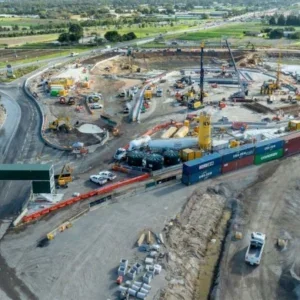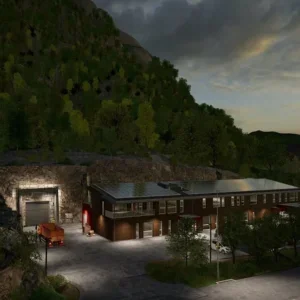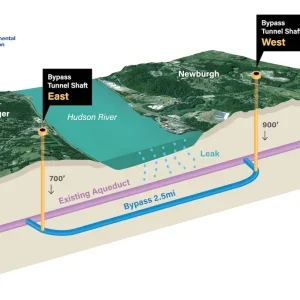Groundwater is the bane of the tunneller’s life. So it is an odd kind of project that welcomes it. In Ningbo in south-east China they are going even further and injecting water to make sure it is there in the rock during excavation.
However, Swedish contractor NCC, one of Scandinavia’s largest firms, knows exactly what it is doing. One of the contractor’s specialities is the creation of caverns for underground storage of, in particular, inflammable gases such as propane and butane. Such caverns rely on groundwater as the seal against leakage as they usually hold the gas in an unlined chamber in a pressurised, or sometimes refrigerated, state.
The firm is creating several pressure storage caverns for liquefied petroleum gas on a coastal site, a half hour’s flight from Shanghai and close to one of China’s most significant economic development zones at Ningbo city. BP/Amoco China is the client in conjunction with local investors.
“For such caverns there should be a slight, but steady, inflow of groundwater when it is in use,” explains PhD Lars-Olof Dahlström, head of the rock mechanical department within NCC, during a visit to the project. “A slight carpet of water on the cavern bottom is formed which drains into a sump for regular pumping out.”
Obtaining groundwater surround was achieved in early projects by careful selection of the geology to ensure a natural high water table, but for some 25 years now caverns have been created using a “water curtain”: a complete covering of the cavern area by a network of small tunnels and drill holes to inject water. “It’s a technique devised in Scandinavia,” says Dahlström.
Time-scales
Theoretically during excavation, an area of ground could be dewatered for the work and then be “topped up” again afterwards. But practically this does not work out, he says: time-scales are too long and there is always the danger of incomplete restoration of the water or shifts in the rock and unforeseen alterations to the geology.
“The usual experience is that there is anyway relatively little water during excavation,” he says. “And while we are not supposed to do extensive grouting, some control grouting is possible.”
NCC is well into construction of the network of tunnels and drill holes which will form the seals for two huge cavern complexes on the site – one sited at a depth of 65m to the crown and one at a depth of 125m.
The first store, comprising two 290m long parallel chambers, each 22m high and 20m wide, will hold butane. This has a lower pressure requirement for storage at normal temperatures. A propane cavern must be lower in the ground to achieve higher pressures because this gas has a lower molecular weight and a higher volatility; plainly speaking, it boils at a lower temperature. Three caverns will form the propane store because site boundary constraints do not allow for just two.
Once in operation, the whole complex will be a so called “bulk break terminal”, explains Herbie Redpath, project manager for BP/Amoco China and head of its site team at Ningbo.
“It will have a very simple operation,” he says, “being ‘wholesale’ rather than ‘retail’, with the gas arriving in very large, 40,000t capacity tankers and being delivered onwards in road tanker lorries or coastal barges.” Small depots elsewhere will either bottle the gas for cooking and heating or put it into local pipeline networks.
The site chosen for the project is ideal for this purpose, lying on the edge of a small island, Daxie Dao, just off the coast from Ningbo and its port. The hilly terrain drops straight into deep water and boats will be able to moor at a jetty, construction of which is part of the project. Road access to the area will be upgraded, to bypass a small village nearby.
Buying time
The large capacity of the caverns, just over 500,000m³: and nearly the largest in the world, has been chosen for this wholesale operation. It allows BP/Amoco China to buy on the world market during price lulls and store large quantities for resale during peak demand. Most gas will arrive from the Middle East.
Redpath himself has been in China for two and a half years, mostly negotiating and re-negotiating the project. It was originally to be half the size, and to be done in joint venture with Chinese partners. But China’s “opening up” policy has made economic conditions more attractive in China for outside investors and BP was able to take a more than 90% stake in the approximately $100M scheme alongside local investors.
The small incremental cost for additional capacity encouraged it to increase the size of the facility.
But although BP has a lengthy track record in China and has been involved in exploration and other work for some years, it has little experience in LPG and particularly in underground storage. A merger with Amoco recently brought in some experience of salt dome and mined storage in the US but even so it decided on an engineer procure and construct (EPC) basis for the project when it called for bids in August 1998. Four firms were shortlisted and it was these that re-bid the revised and enlarged scheme in 1999. Bids were judged using the tender’s front-end engineering design as the reference even though each group was allowed to propose alternatives.
Specialist engineer
Front end engineering was prepared by Geostock, a French specialist engineer of underground storage facilities, owned by a group of oil companies and with 20 years experience designing caverns from leached salt deposit to depleted oilfields. The firm carried out the site investigation and feasibility study at Ningbo and is cavern construction manager for BP, integrated into the client’s team.
NCC teamed up with Japanese process specialist Chiyoda for the approximately $60M bid and was eventually awarded the contract in March last year. Though Chiyoda is lead contractor, its site presence is currently limited as it will be taking care of the plant and process equipment. NCC is the firm with underground rock skills.
A smaller preparation contract had already been let for the 1,000m long construction access tunnel and site shaping. Excavation of this helped confirm the excellent quality of the rock in this area for the caverns, already well investigated by the client previously.
“We are in a volcanic area with cinerites and breccias in the main,” says Linus Levinson, the NCC technical manager for the project. “The rock is conglomerates and pyroclastic material ranging from 80-220MPa though mostly towards the latter.”
There are three dominant joint sets, he says, and cracking. Block sizes are 200mm to 1m upwards.
Most of the 14m² cross-section water curtain tunnels formed as an umbrella are finished. Excavation is by drill and blast using Tamrock drills and, to cope with fairly difficult access, a Toro 501D loader was used to fill the Kiruna 35t dumptrucks that move spoil to the surface. They will also serve for the main excavation eventually taking a total 560,000m³ of rock to a dump area on the sea coast. A small “reclaim” will be formed, accessed by a new haul road that will eventually be part of the site’s permanent roads.
NCC has brought much of the equipment in for the work though it has subcontracted shaft construction and much of the drill and blast work to the Chinese state owned 6th Engineering Bureau of Hydropower & Water Conservancy. The earlier work was done by a bureau from the Ministry of Railways.
“The 6th Engineering Bureau has some 400 workers on site and we organise a team of expatriate instructors to work with them,” explains Levinson. “Some work we do directly because we are more experienced.” Generally, the Chinese workers are very competent, he says.
Umbrella formed
The NCC is currently working out of two branches to this steeply curving access tunnel to create the network of smaller tunnels and drill holes that form the “umbrella”. The 115mm holes are made using mainly DTH hammers.
“The holes are up to 100m long and need to be very accurate,” he explains. They form an interlocking network which must be in place and be correctly pressurised at least 20m ahead of any cavern excavation work below. Water loss measurement tests and pressure tests are done at the drill locations and monitored on a daily basis. Tests will also be done from monitoring holes at the above ground facilities after completion.
Cavern excavation preparations began in November last year and the work is due to run until August this year, with the main part starting in March.
There has been considerable discussion on this, says Dahlström, particularly over cavern design, blasthole lengths and benching. NCC is using conventional tunnelling methods in the top heading with drilling rounds of 5.3m length. To guarantee accuracy the client’s engineer initially requested a 4m length restriction for blasting. BP/Amoco and Geostock have now accepted longer rounds along with the mounting of a guidance system on the drill rigs.
“We are well experienced because of more stringent specifications in Scandinavia where the state of the art systems in both drilling accuracy and monitoring equipment for borehole deviation have been developed,” says Levinson.
“A compromise solution has been reached which involves a combination of vertical and horizontal benching. The best saving for us and the client is in time; cavern excavation will be reduced from 10 months to nine months.
“And vertical benching is much less demanding on explosives; we can use around 0.4kg/m³ of the emulsified explosive on vertical benching whereas it demands up to 0.9kg/m³ for the horizontal.”
The main caverns will be made using three Atlas Copco boomer rigs and Brøyt loaders from Norway for the Kiruna trucks. “The Brøyts may look a bit awkward but they move a lot of material,” said one of the Swedes. “They can also be used in electrical powered configuration to cut pollution.”
One constraint, the Scandinavian team feel, is the relatively small size of the access tunnel which is 6.5m high and with a 45.1m² cross section. “We feel an 8m tunnel would have been better,” says Levinson. It is not simply passing constraints for the Kiruna trucks but also ventilation that has caused the problem. Available ventilation systems on site were not sufficient for the work so NCC brought in powerful Removex fans and Swedvent equipment which feed two 1,800mm and two 1,600mm diameter ducts; these almost fill the upper part of the access tunnel.
Even though exhaust emissions are reduced by filters on the trucks the fans are power hungry and so the site has four big Caterpillar generator sets to provide 4000kVA, more than half going to the fan sets. “The local grid would not take the loads and there are interruptions sometimes,” says Levinson.
One area of clear agreement between the client and contractor has been in the imposition of high safety standards on site, particularly in the Chinese context. Site and construction safety is an area where China lags because its large scale industrialisation and construction is no more than two decades old. Manual and even skilled workers are often drawn from rural areas and that has meant the overall site culture has not developed the same safety attitudes as in Europe, for example. Sometimes the right safety equipment is not available.
Most western firms will say that the Chinese companies are very willing to learn procedures. “But it must be closely monitored, something that NCC is learning as it has its first Chinese experiences,” says Redpath.
“NCC has imposed a bonus and penalty system, which is common in China, to achieve safety for everything from complex drilling activity and welding to wearing earplugs.”
So far so good. The heaviest work begins in March when the main chamber benching excavations are begun, starting with the first 7m high bench. The scheduled date for finishing them is July by which time Chiyoda should be well established on site fitting the pipework, monitoring equipment and heat exchangers that will let the big tankers offload their liquid cargoes into the caverns below.
Related Files
Location of Ningbo in relation to major cities in China
Section through shaft and pipe system
Section through shaft and pipe system







